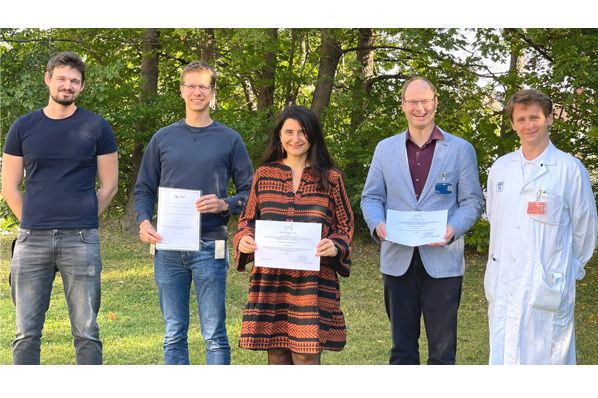
(Vienna, 15 October 2021) At its 37th Annual Meeting, the Austrian Society for Radiation Oncology, Radiobiology and Medical Radiophysics (ÖGRO) awarded all three prizes for the best scientific papers in the field of radiation oncology to staff working at the Department of Radiation Oncology of MedUni Vienna - Vienna General Hospital. At the three-country conference of the Austrian, German and Swiss medical physics societies (ÖGMP, DGMP, SGSMP), the Austrian Society for Medical Physics (ÖGMP) also awarded its two prizes for medical physics to researchers from the Department of Radiation Oncology.
The two ÖGRO awards for clinical radiation oncology went as equally placed first prizes to Alina Sturdza and Matthias Moll, Hermann Fuchs receiving the prize for medical physics and radiobiology. The ÖGMP awarded its Best Abstract Prize for Medical Physics to Gerd Heilemann, while Lukas Zimmermann was distinguished for the "Best Paper".
Joachim Widder, Head of the Department of Radiation Oncology and Comprehensive Cancer Center (CCC) of MedUni Vienna and Vienna General Hospital, who was also the conference president of the 37th Annual Meeting of the ÖGRO, commented: "This year, for the first time, all three ÖGRO prizes and two ÖGMP prizes went to researchers from the Department of Radiation Oncology at MedUni Vienna and Vienna General Hospital. We congratulate all five award winners on their success. The awards underscore the excellent quality of research being carried out in our department and indicate that our work is on the right track."
Development of a predictive model
Alina Sturdza developed the first nomogram to predict overall survival (OS) in locally advanced cervical cancer (LACC) after image-guided adaptive brachytherapy (IGABT) in the context of definitive radiochemotherapy (RCT).
For this project, 720 female patients from 12 international treatment centres were included in a study. In addition to the previously described prognostic factors of age, FIGO stage, infiltration of the corpus uteri, administration of chemotherapy, total treatment time, and lymph node involvement, response to teletherapy and chemotherapy were also found to be essential predictive factors. These results could facilitate individual counselling of patients during treatment. Based on the calculated data, an online app was developed to estimate individual overall survival.
The paper is titled "Predicting overall survival in locally advanced cervical cancer using nomograms after image-guided brachytherapy: a retro-EMBRACE study".
Two radiotherapies compared
Matthias Moll received the award for the paper "Treatment of low-risk prostate cancer: a retrospective study comparing EBRT and seeds brachytherapy in terms of biochemical control and late side effects".
The aim of the study was to compare external beam radiotherapy (EBRT) and seed brachytherapy with regard to biochemical control and late gastrointestinal and urogenital side effects.
This study included 477 patients treated at the Department of Radiation Oncology at MedUni Vienna and Vienna General Hospital between 2000 and 2019.
Moll was able to show that there is no significant difference between the two modalities in terms of biochemical control. Seed implant brachytherapy causes fewer late gastrointestinal side effects than EBRT, while EBRT causes fewer late urogenital side effects. The results obtained by Gregor Goldner's team are comparable with those obtained in international studies: Both treatment modalities provide excellent tumour control with a 95% cure rate at 5 years.
Detectors on the trail
In his publication "MR guided proton therapy: Impact of magnetic fields on the detector response" Hermann Fuchs addressed the features and suitability of clinically available detectors for dose measurement in proton therapy in magnetic fields.
Background: the combination of on-line MR imaging and proton therapy offers new possibilities that have great relevance for clinical application. In ion beam therapy, such an imaging option is particularly advantageous due to the greater sensitivity of the radiation. In contrast to conventional photon therapy, such a hybrid device has not yet been clinically implemented due to the many scientific and technical challenges involved.
Personalised high-precision radiotherapy
Gerd Heilemann received the Austrian Society for Medical Physics (ÖGMP) award for the best submitted paper for his study "Generating treatment plans from dose distributions on segmented CTs with Deep Learning: A feasibility study".
In this project, he successfully developed the first AI-based model capable of generating treatment plans from patient contours and dose distributions. This promising approach is of great interest for automated radiotherapy planning. Models like this for the creation of treatment plans for prostate cancer could pave the way for even more highly personalised high-precision radiotherapy.
The study was carried out with the team comprising Marco Peer (Vienna University of Technology), Lukas Zimmermann and Wolfgang Lechner, under the direction of Dietmar Georg.
Synthetic MR and CT images via Artificial Intelligence
Lukas Zimmermann received the author award from the journal "Zeitschrift für Medizinische Physik" [Journal of Medical Physics] for his publication "Latent space manipulation for high-resolution medical image synthesis via the StyleGAN", which was published last year.
It describes an artificial intelligence (AI) based method for generating synthetic MR and CT images in the pelvic region in a controlled manner. This makes it possible to share medical data with other institutions without any impact in terms of data protection. Furthermore, this data can be used to train AI algorithms to counteract the problem of limited patient data. This should result in more robust and accurate AI models in the future. The work was done in collaboration with the University of Umeå in Sweden.